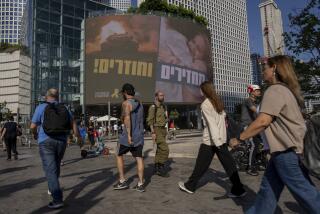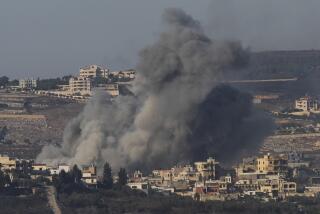Crisis is growing in Aleppo
BEIRUT — As explosions and gunfire sounded in the distance, the parishioners of St. Joseph’s Church in Aleppo, Syria, prayed for peace Tuesday evening.
“People are terrified,” Chaldean Christian Bishop Antoine Audo said by telephone from Aleppo after the Mass. “They fear a situation that is becoming more and more violent and uncertain.”
Syria’s most populous city endured another day of shelling, street battles and reported strafing from helicopter gunships. Tens of thousands of people have fled. Pickups and cars filled with families and their belongings have been streaming out as rebel gunmen battle government forces.
But not everyone has been able to leave. The United Nations reported Tuesday that thousands remain trapped in the sprawling city of more than 2 million, which has become the focal point of the more than 16-month rebellion against President Bashar Assad.
The crisis in the city is becoming ever more dire, say aid workers, who fear a looming humanitarian catastrophe. Bread is in short supply; people are waiting in lines for hours to grab what is available. Gasoline, if it’s available, is prohibitively expensive. Cooking oil is hard to find.
People who have fled battle zone districts are seeking shelter in crowded schools, parks and dormitories. Volunteers are endeavoring to provide food and water as the fighting rages.
“The situation is extremely tense and volatile,” said Rabab Rifai, spokeswoman with the International Committee of the Red Cross in Damascus, the capital.
The battle for the city may escalate within days. The government has yet to push forward with scores of tanks said to be positioned on the city’s outskirts. The military could also step up shelling and aerial attacks in a bid to regain control of Aleppo, which many analysts say Assad cannot afford to lose.
The fighting has been concentrated in a semicircle of districts seized by rebels almost two weeks ago, including the Salahuddin neighborhood, its streets and alleys the scene of intense battles.
Rebels seized three police stations Tuesday after punishing battles that cost many lives, opposition activists said. The government said its forces had inflicted heavy losses on “terrorists,” its label for armed rebels.
But some areas of Aleppo, like the predominantly Christian Sulaymaniyeh district where Audo said Mass Tuesday, have so far been spared much of the violence. Many people have arrived from other hard-hit districts, the bishop said.
“People are sleeping in schools, in parks,” he said. “There is a great human need now.”
There is a pervasive fear that the violence will spread, creating an even greater refugee flow and more chaos.
Many people leaving Aleppo have headed for nearby Turkey, where tens of thousands of Syrians were already finding shelter in tent cities set up by Turkish authorities. Along the border, a pair of women from the battered Salahuddin district rested in the shade of an olive tree.
“They’re telling us that the situation in Aleppo is going to get worse,” said one of the women, who gave her name as Um Mujahid, as her infant son cried beside her.
The two sisters fear that nothing will be left if government forces intensify their attacks.
“They are shelling randomly and some are saying they might turn tanks on all Aleppo’s neighborhoods, even the calm ones, to destroy the city,” said Um Mujahid.
Salahuddin is a working-class district, but the crisis has also hit wealthy and middle-class neighborhoods and families. Among those fleeing are members of Aleppo’s merchant gentry, long viewed as stalwarts of the Assad government.
A factory owner from Aleppo who crossed into Lebanon last week recounted how he fled with his family in a car to the city’s international airport, passing the bodies of at least five soldiers along the deserted roadway.
Until recently, Assad could argue that his administration had provided a stable environment for business and commerce. But the factory owner, who asked to be identified only as Ayman, said no one in his circle of merchant friends still supported Assad.
“Even those who were with the regime saw how the shells are falling randomly,” he said.
For Aleppo’s Christians, a minority accounting for 8% to 10% of the city’s population, there is a profound fear of the unknown.
For all its repression of dissent, the Assad government was tolerant of religious minorities; its ruling clique was dominated by Assad’s Alawite sect, itself a minority.
Syria’s Christians, like other minorities, have generally been regarded as supportive of Assad, though there are many Christian and other minorities in the opposition.
The rebellion draws most support from Syria’s majority Sunni Muslim community.
“People don’t know what will come next,” said Audo, who is the Chaldean Christian bishop for all of Syria. “We are looking at what happened in Egypt, in Tunisia, in Iraq, the uncertainty.”
Still, he noted a long tradition of Christian-Muslim cooperation and mutual respect in Aleppo. He said the young men of the Christian Sulaymaniyeh district were staying out of the fight, though some sympathized with the rebellion.
Syria’s Christians sheltered many co-religionists who fled Muslim extremism in neighboring Iraq, where churches were bombed and Christian stores burned after the U.S.-led overthrow of Saddam Hussein, a secular autocrat, like Assad.
And Syrian Christians are well aware of reports of rebels targeting Christians in central Homs province, a center for conflict long before Aleppo became a battleground.
“When I’m asked about Syria, the first thing I say, generally, is that we don’t want to become like Iraq,” the bishop said. “That fear is very present with us. That would mean the destruction of a Christian presence in Syria that has been here since the beginning of Christianity.”
--
Special correspondent Alexandra Sandels and a Times staff writer along the Syrian-Turkish border contributed to this report.
More to Read
Sign up for Essential California
The most important California stories and recommendations in your inbox every morning.
You may occasionally receive promotional content from the Los Angeles Times.









